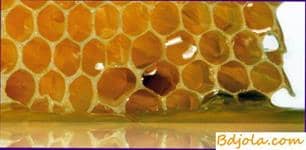
Remarkable properties of wax attracted the attention of man in ancient times. It is established that in ancient Egypt it was widely used in sacrifices. In ancient Rome and Greece, wax candles burned in the temples in honor of the gods. In pre-revolutionary Russia, huge amounts of wax were also used to illuminate the churches.
Since ancient times and right up to the invention of writing paper, flat wooden plaques were used, covered on the one side with an even layer of wax, on which letters were written. About the use of wax, in particular waxed pieces of cloth, told in their works Homer, Aristophanes, etc. Wax has high preservative properties. Scythians, Iranians and other peoples used wax to embalm the corpses of prominent statesmen.
For many centuries, artists used wax paints, which have a beautiful shine and great strength. This is evidenced not only by literary sources, but also by archaeological finds. As a result of excavations of the cities of Pompeii and Herculaneum, produced in 1706, a wall wax painting was discovered, which decorated many centuries ago the living rooms of wealthy Pompeians and Herculaneum. Despite the fact that the wax painting was under the earth for almost 18 centuries, it retained its beauty and brightness of colors. And although at the present time new techniques have replaced wax painting, wax remains an integral part of oil paints.
Widely used beeswax. In Russia, wax busts and models were made in the XVIII century. Many beautifully executed wax portraits have survived, amazing with their freshness and grace. Of great importance is beeswax in the manufacture of medical models, which play an exceptionally important role in the educational process. They provide an opportunity to see diseases, especially skin diseases, which are rare occurrences.
Until 1918, beeswax served mainly for the manufacture of church candles. Now wax is extremely important for the national economy: 40 industries use it as raw materials. It is widely used in foundries, electrical engineering, electroplating, telephone technology, optics, radio engineering, railway transport, textile, leather, perfume, aviation, metallurgy, glass, automotive, pharmaceutical, confectionery, printing, paint, chemical, paper, woodworking and other types of industry.
Wax is a part of the ski ointment, mastics for grafting trees, ointments for harnesses, vaccines for shoes, sealing wax, cement for gluing marble and gypsum, pencils for drawing on glass, etc. Recently, Canadian scientist S. Peach (1971) reported on the use of wax at photographic works. Adding beeswax to photoproducers reduces the consumption of reagents by 20-25%. Wax is used in dentistry in the manufacture of dentures.
Candidate of Technical Sciences N. Yakobashvili (1962) developed a technology for obtaining an extract from beeswax. Petroleum ether was used as a solvent. The fragrant substance extracted from beeswax – essential oil – is a new and valuable product for the perfume industry and can be used for the production of high-quality perfumes.
A fragrant essential oil from wax is not inferior to expensive pink and jasmine oils by its qualities, and at a cost much cheaper than them. A ton of beeswax produces more than 5 kg of oil, and the remaining wax does not lose its numerous industrial qualities. Wax takes a big place in medicine and now. Plasters, ointments and creams are made in pharmacies only on beeswax. We give the names of medicines for the manufacture of which you need wax: plasters – sticky, mercury, wax, soap; ointments – wax, spermaceous, lead, zinc, etc.
Пчелы безматочный. Как очистить пчелиные рамки.
Beeswax